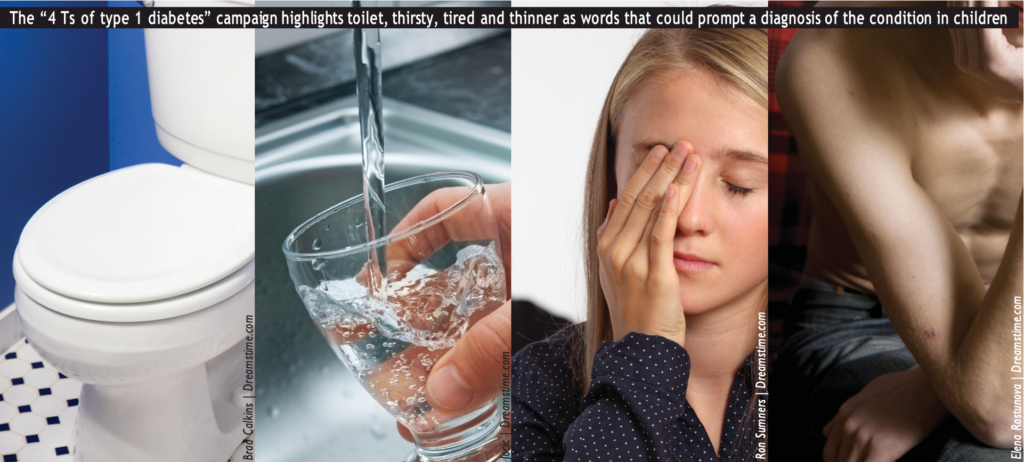This content was published in 2013. We do not recommend that you take any clinical decisions based on this information without first ensuring you have checked the latest guidance.
Summary
Type 1 diabetes is caused by the autoimmune destruction of the insulin- producing b-cells of the islets of Langerhans. Genetic and environmental factors are thought to play a part in the onset of the disease, which usually occurs in childhood and young adulthood.
A capillary blood glucose level of greater than 11mmol/L alongside a history of classic osmotic symptoms (polyuria and polydipsia) supports a diagnosis of type 1 diabetes; many patients will be admitted to hospital with diabetic ketoacidosis in the first instance. Insulin administration is needed to control blood glucose levels, and optimising overall glycaemic control can help prevent long-term micro- and macrovascular complications.
Diabetes mellitus manifests as a chronically raised blood glucose level (hyperglycaemia) which can result in premature morbidity and mortality. It is characterised by a lack of insulin production, a defect in how insulin is used by the body, or both. Diabetes is most commonly classified as type 1 or type 2. The pathophysiological processes that lead to the development of each type differ and so can manifest in clinically distinct patient groups. Other types of diabetes include monogenic diabetes and gestational diabetes. This article will focus on the cause, clinical features and implications of type 1 diabetes.
Pathophysiology
Insulin is normally synthesised in the pancreas by the b-cells of the islets of Langerhans in response to a glucose stimulus. Type 1 diabetes is fundamentally caused by the autoimmune destruction of these insulin-producing cells. This results in an absolute deficiency of the hormone, with patients having a lifelong dependency on exogenous sources
Current understanding of the pathogenesis of type 1 diabetes is based on a hypothesis first postulated by the American immunologist George Eisenbarth in the 1980s. It is thought that autoimmune b-cell destruction is triggered by an infective or environmental stimulus in genetically predisposed individuals. Recent research has also focused on the role of weight gain and insulin resistance as important accelerators of b-cell destruction in type 1 and type 2 diabetes.1
Type 1 diabetes is often considered a disease of rapid onset; however its development is a much slower process involving progressive immunological damage. Dr Eisenbarth proposed that an infective or environmental trigger (see Box 1) results in insulitis — an invasion of pancreatic islets by T-lymphocytes leading to b-cell destruction. This process can last for months or years and is characterised by the development of islet cell antibodies (detected in 85% of patients at diagnosis). After approximately 80% of pancreatic b-cells have been destroyed, clinical symptoms will begin to develop — often manifesting at a time of increased insulin demand (eg, during an infection).
Epidemiology
Although a lot of attention has focused on the global pandemic of type 2 diabetes, a similar increase in the incidence of type 1 diabetes — of about 3–4% per year — has also been observed. Almost three million people in the UK are estimated to have diabetes and some 10% of them have type 1 disease.4
There are huge variations in the incidence of the disease throughout the world. The highest rates are seen in Finland and Scandinavia (48–49 per 100,000 people per year) — almost 100 times higher than in rural China. The UK is considered to have a high incidence, and has the fifth highest rate in children (24.5 cases per 100,000 people per year).5
Type 1 diabetes is most likely to be diagnosed in childhood or young adulthood, but it can appear at any age. The peak age of presentation is 10–14 years. The greatest increase in the incidence of type 1 diabetes in recent years has been among children below the age of five years, possibly due to a higher exposure to environmental triggers. Increased bodyweight and the subsequent development of insulin resistance in young children may also be contributing to this shift towards earlier onset.
Onset of the disease tends to be more aggressive for children and adolescents than for people who develop diabetes in adulthood — another peak in the incidence of type 1 diabetes has been observed at around 40 years. It is not unusual for this latter group of patients to be diagnosed as having type 2 diabetes. However, testing positive for islet cell antibodies indicates type 1 disease and these patients tend to need insulin therapy much earlier. Patients in this group are sometimes referred to as having latent autoimmune diabetes of the young, or type 1.5 diabetes.
Box 1: Genetic and environmental factors
Although there can be a strong genetic predisposition to the development of type 1 diabetes, more than 85% of patients will have no first-degree relative with the disease. Several observations support the theory that genetic and environmental factors play a part in the onset of type 1 diabetes.
The concordance rate in identical twins is approximately 50%, suggesting that susceptibility to developing the condition depends on more than just genetics. Clinical symptoms are also more likely to present for the first time over winter and unexplained peaks in incidence have been shown to occur.
Finally, migrating populations have been shown to adopt the incidence rate of type 1 diabetes of their new countries. For example, incidence rates among south Asian children in Leicester are comparable to those of both white children and children from other ethnic backgrounds.2
Genetic predisposition The human leukocyte antigen (HLA) locus on chromosome 6 contributes to approximately 50% of the familial cases of type 1 diabetes. The HLA genes DR4-DQ8 and DR3-DQ2 are present in 90% of children with type 1 diabetes. The HLA gene DR15-DQ6 is thought to have a protective role and is present in less than 1% of children with the condition.
Environmental triggers The hygiene hypothesis proposes that exposure to environmental microbes and pathogens in early life is important for the development of immunity. The current lack of early priming of the immune system in this way (caused by a modern, clean environment) results in a deficiency in immunoregulation. If pathogens are then encountered at a later date, autoimmune diseases can be triggered. Several viruses (eg, mumps, rubella and coxsackie virus) and dietary factors (eg, early exposure to cow’s milk or gluten) have been suggested as triggers for autoimmune b-cell destruction.
It has also been proposed that vitamin D protects against the development of type 1 diabetes,3 but this has not been proved. In fact, the only factor that has been convincingly associated with the development of islet cell antibodies, and subsequently type 1 diabetes, is congenital rubella infection.
Clinical features and diagnosis
Symptoms are typically present for three to four weeks before diagnosis and are usually related to the osmotic effects of glucose. Common symptoms include polyuria and polydipsia, which occur as a result of osmotic diuresis, secondary to hyperglycaemia. Symptoms are usually accompanied by marked fatigue, significant weight loss and the development of a catabolic state. Patients may also notice blurred vision, caused by a change in lens refraction, which will usually resolve when glucose levels have been normalised. High levels of glucose in the urine can lead to frequent infections in the urogential system (eg, urinary tract infections and candidiasis). A substantial number of people with undiagnosed type 1 diabetes are admitted to hospital with diabetic ketoacidosis (DKA) — see Box 2.
Type 1 diabetes is usually diagnosed by a capillary blood glucose level of greater than 11mmol/L alongside a history of classic osmotic symptoms and weight loss. Patients should also be assessed for the presence of ketones in the blood or urine. If ketones are detected then patients should be referred to a specialist diabetes service, or emergency department, on the same day. Children and adolescents should always be referred to a specialist paediatric diabetes service the same day they are diagnosed.
Approximately 2,000 children are diagnosed with type 1 diabetes each year in the UK and a quarter will have DKA at the time of diagnosis. (This figure rises to 35% in children under five years of age.) DKA is associated with a high rate of mortality, and management requires intensive intervention. This can be deeply traumatising to patients and their families and is costly to the NHS.
Diabetes UK has recently launched a national campaign to increase awareness of the most common symptoms of type 1 diabetes in children. The “4 Ts of type 1 diabetes” campaign highlights four key words that are associated with diagnosing the condition in children — toilet, thirsty, tired and thinner.6 These symptoms are often missed in younger children and bed wetting or heavy nappies can be noticeable signs of polyuria in this age group.
Box 2: Diabetic ketoacidosis
In the absence of insulin, glucose cannot be used by the body and blood glucose levels rise. The liver responds by increasing hepatic glucose output via glycogenolysis and gluconeogenesis, worsening hyperglycaemia. Insulin also suppresses lipolysis and, in its absence, fat is consequently broken down. The resulting free fatty acids are converted into ketones in the liver. Ketones are acidic, and their accumulation results in life-threatening systemic acidosis. This triad of hyperglycaemia, ketosis and acidosis is known as diabetic ketoacidosis (DKA).
The clinical features of DKA include nausea, vomiting, abdominal pain, drowsiness and, in extreme cases, coma. Patients are often profoundly dehydrated at presentation. Shortness of breath can also occur as the body attempts to neutralise the metabolic acidosis caused by the ketones. Fruit-smelling breath can also indicate the presence of excess ketones in the body.
Information on how to identify and manage DKA in adults can be found in a previous Clinical Pharmacist article (2011;3:375).
Morbidity and mortality
Before the advent of insulin therapy in the 1920s a diagnosis of type 1 diabetes meant certain death. When insulin was discovered, the aim of therapy was to sustain life by the amelioration of hyperglycaemia and prevention of metabolic decompensation. Over the 20th century the role of insulin therapy evolved to include the prevention of diabetes-related complications. Further advances in the understanding and treatment of the condition have helped reduce mortality and morbidity rates.7
Nevertheless, a recent national diabetes audit — which examined outcomes in patients with diabetes in England and Wales — revealed cause for concern. The 2010–11 national diabetes audit report highlighted an increased death rate of 135% in people with type 1 diabetes compared with the general population — much higher than the excess mortality of 36% among people with type 2 diabetes.8 The number of hospital admissions for patients with DKA in England and Wales is also rising. The prevalence of patients being admitted to hospital with one or more episodes of DKA each year was found to be over 3%. The results of the audit also revealed that young women (aged 15–34 years) are nine times more likely to die than their non-diabetic counterparts and people from lower socioeconomic groups have the poorest outcomes.9
In the longer term, hyperglycaemia can result in both small and large vessel disease
Complications
The morbidity and mortality associated with type 1 diabetes is related to both short- and long-term complications. Short-term complications occur as a result of metabolic decompensation caused by episodes of hyper- and hypoglycaemia. In the longer term, hyperglycaemia can result in both small and large vessel disease.
Microvascular complications comprise diabetes- associated retinopathy, nephropathy and neuropathy. Diabetes remains the leading cause of blindness in the working population and the leading cause of end-stage renal disease requiring dialysis. Macrovascular disease manifests as premature cardiovascular, cerebrovascular and peripheral vascular disease. A combination of micro- and macrovascular disease may give rise to diabetic foot disease, which in some individuals can result in limb amputation.
Poor glycaemic control over time is known to hasten the progression of long-term complications, which often carry substantial morbidity and mortality risks. These complications are discussed in more detail in a previous Clinical Pharmacist article (2009;1:475).

Optimising glycaemic control
In 1993, the landmark “diabetes control and complications trial” (DCCT)10 demonstrated beyond doubt that improved glycaemic control — maintaining a glycosylated haemoglobin (HbA1c) of 7.1% (54mmol/mol) compared with 9% (75mmol/mol) — early in the course of diabetes significantly reduced the development and progression of microvascular outcomes over a six and a half-year study period. However, this strict control caused a two-to- threefold increase in the rate of severe episodes of hypoglycaemia. Researchers continued to observe outcomes in more than 90% of the original DCCT participants. The “epidemiology of diabetes interventions and complications” (EDIC) study analysed patient outcomes some 17 years after the start of the DCCT and revealed that the original tight glycaemic control group (HbA1c of 7.1%) continued to demonstrate improved microvascular outcomes,11 and also showed reductions in macrovascular disease.12 The EDIC study researchers proposed that a “metabolic memory” accounted for the benefits of early tight glycaemic control being seen in later years.
For patients with type 1 diabetes, optimising glycaemic control is paramount to preventing the emergence and progression of complications. However, reaching glycaemic targets and avoiding hypoglycaemia remains challenging.
Modern treatment options and strategies have been shown to help patients achieve better glycaemic control without increasing their risk of hypoglycaemia. In light of the outcomes of the national diabetes audit and in acknowledgement of the particular challenges in managing type 1 diabetes, the Association of British Clinical Diabetologists has recently launched a campaign to improve patients’ access to specialist diabetes services.13 Living with type 1 diabetes has been described as facing a lifetime of inconvenience and restraint resulting from the perpetual need to juggle insulin dose, diet and exercise.14 Therefore, those with the disease are likely to appreciate the effort made by health professionals — including pharmacists — to understand their needs and provide support. The accompanying article discusses the treatment of adults with type 1 diabetes.
References
- Wilkin T. The accelerator hypothesis: Weight gain as the missing link between type 1 and type 2 diabetes. Diabetologia 2001;44:914–22.
- Raymond N, Jones J, Swift P, et al. Comparative incidence of type I diabetes in children aged under 15 years from south asian and white or other ethnic backgrounds in Leicestershire UK from 1989 to 1998. Diabetologia 2001;44:S3.
- Mathieu C, Badenhoop K. Vitamin D and type 1 diabetes mellitus: State of the art. Trends in Endocrinology and Metabolism 2005;16:261–6.
- Diabetes UK. Diabetes in the UK: Key statistics on diabetes 2012 www.diabetes.org.uk/Documents/Reports/Diabetes-in-the-UK-2012.pdf (accessed January 2013).
- Diabetes UK. List of countries by incidence of type 1 diabetes for ages 0 to 14. www.diabetes.org.uk (accessed January 2013).
- Diabetes UK. The 4 Ts Campaign 2013. www.diabetes.org.uk/ Get_involved/Campaigning/4Ts-campaign/ (accessed January 2013).
- Miller R, Secrest A, Sharma R, et al. Improvements in the life expectancy of type 1 diabetes: The Pittsburgh epidemiology of diabetes complications study. Diabetes 2012;612:987–92.
- Health and Social Care Information Centre. National diabetes audit mortality analysis 2010–11: Complications and Mortality. www.briefing.diabetes.nhs.uk/i/assets/NDA_10-11_Report%202_ Complications_and_Mortality.pdf (accessed January 2013).
- NHS Information Centre. National diabetes audit mortality analysis 2007–08. www.hqip.org.uk/assets/NCAPOP-Library/Diabetes-Audit- Mortality-Audit-Report-2011-Final.pdf (accessed January 2013).
- Diabetes Control and Complications Trial Research Group. The effect of intensive treatment on the development and progression of long-term complications in insulin dependent diabetes. New England Journal of Medicine 1993;329:977–86.
- The Diabetes Control and Complications Trial/Epidemiology of Diabetes Interventions and Complications Research Group. Retinopathy and nephropathy in patients with type 1 diabetes four years after a trial of intensive therapy. New England Journal of Medicine 2000;342:381–9.
- The Diabetes Control and Complications Trial/Epidemiology of Diabetes Interventions and Complications (DCCT/EDIC) Study Research Group. Intensive diabetes treatment and cardiovascular disease in patients with type 1 diabetes. New England Journal of Medicine 2005;353:2643–53.
- Association of British Clinical Diabetologists. ABCD type 1 diabetes campaign 2012–13. www.diabetologists-abcd.org.uk/Type1_Campaign.htm (accessed January 2013).
- Jeffcoate W. Drive to eliminate the burden of type 1 diabetes. Lancet 2006;367:795–7.


